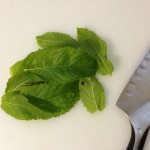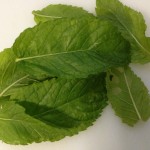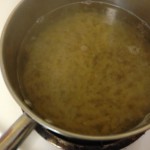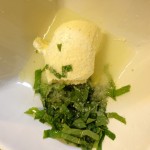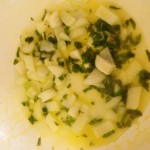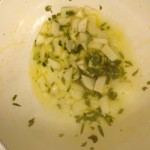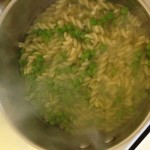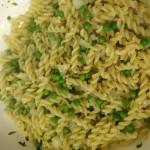 This Meatless Monday, we feature peas, with growing, storage and prep tips, as well as recipes for Pasta with Lemon-Mint Butter and Fresh Peas and Green Pea Soup from Vermont Fresh: A Fruit and Vegetable Handbook.
This Meatless Monday, we feature peas, with growing, storage and prep tips, as well as recipes for Pasta with Lemon-Mint Butter and Fresh Peas and Green Pea Soup from Vermont Fresh: A Fruit and Vegetable Handbook.
Background
Peas, like beans, are legumes, meaning they have pods that split open to reveal a row of seeds attached to one side. The seeds of legumes are the part that we eat, sometimes once they are mature (as in the case of dried beans) and sometimes when they are immature, which is the case for peas. Fresh peas can generally be divided into three categories: shell peas, snap peas, and snow peas. Snow peas (flat) are eaten whole, pod and all, before the inner peas are very developed. Snap peas are also eaten whole, but the pods are rounder with larger peas inside. Shell peas are stripped from the shell once the inner peas are round and plump—these are the peas that are familiar to almost everybody as the round green peas that can be found frozen or canned in any supermarket. Peas are an ancient crop that date back to 7000 BCE (Before the Common Era). They were eaten by both the Greeks and the Romans and have been a traditional springtime treat throughout written history.
Growing Tips
Peas love cool, wet, springtime weather and are often the first crop a gardener plants outside. They should be direct seeded as soon as the soil can be worked. Peas are frost tolerant, but will germinate best when the soil has warmed slightly. Depending on the type of pea, it is likely that you will need to provide them with some fencing or trellising to climb up. Plant seeds about 1 inch deep and 1 inch apart from each other. Keep well-watered. Harvest shell and snap peas once the pods have filled out but before the taste is starchy and bitter (sample a few peas if you aren’t sure). Snow peas should be harvested when the pods are still flattish and are several inches in length. Some varieties will continue to yield with regular harvesting. Peas fix nitrogen into the soil, making them a good crop to rotate around your garden.
Storage
Peas do not store especially well and are best eaten as soon as possible after harvesting. The sugars in peas turn to starch rapidly after picking, especially at warm temperatures. If not being eaten right away, peas should be stored in the crisper drawer of your refrigerator, tightly wrapped in plastic.
Nutritional Benefits
Peas are high in protein, fiber, and carbohydrates as well as various vitamins and minerals, including iron and Vitamin C. Peas contain several phytochemicals that act as antioxidants.
Preparation
Rinse pea pods in cold water. Snap off the stem end with your fingers and pull off the stringy fiber on the back side. For snap and snow peas, that is sufficient. For shell peas, squeeze open the pod, then push out the peas with your thumb. Peas are delicious both raw and cooked.
Meatless Monday Recipe: Pasta with Lemon-Mint Butter and Fresh Peas
Judy Stermer, our own Director of Communications, tasted and tested this recipe out of the Vermont Fresh Handbook. Her comments and adjustments are in italics.
Serves 6
(adapted from ecurry.com)
Ingredients
- 1 stick butter, softened
- 1 large handful fresh mint leaves, minced
- Juice of 1 lemon
- 1 teaspoon salt
- 1 pound pasta
- 1 small sweet onion, diced
- 1 cup peas, shelled
- Pasta with Lemon-Mint Butter and Fresh Peas. Photos courtesy of Judy Stermer.
- Pasta with Lemon-Mint Butter and Fresh Peas. Photos courtesy of Judy Stermer.
- Pasta with Lemon-Mint Butter and Fresh Peas. Photos courtesy of Judy Stermer.
- Pasta with Lemon-Mint Butter and Fresh Peas. Photos courtesy of Judy Stermer.
- Pasta with Lemon-Mint Butter and Fresh Peas. Photos courtesy of Judy Stermer.
- Pasta with Lemon-Mint Butter and Fresh Peas. Photos courtesy of Judy Stermer.
- Pasta with Lemon-Mint Butter and Fresh Peas. Photos courtesy of Judy Stermer.
- Pasta with Lemon-Mint Butter and Fresh Peas. Photos courtesy of Judy Stermer.
Instructions
- In a small bowl, combine the butter, mint, lemon juice, and salt. Beat together until well blended, then refrigerate.
- Cook the pasta according to the directions on the package. Drain, reserving 3 tablespoons of the cooking liquid.
- Melt a large spoonful of the mint butter in a large pot over medium heat. Add the onion and cook several minutes, until slightly tender.
- Add the reserved pasta liquid and the peas. Turn heat to medium high and cook about 3 minutes. Add the pasta to the onion and peas and cook just a few minutes longer, tossing frequently—peas should remain bright green.
- Serve immediately with the extra mint butter.
Note: this recipe is meant for shell peas, but is superb with snow peas as well!
This is a very simple dish but the taste of fresh peas really can’t be beat. I loved the tartness of the lemon mint butter. And while this dish was tasty hot, it would also be great at room temperature.
Meatless Monday Recipe: Green Pea Soup
Serves 6
(adapted from Gourmet, March 2001, and epicurious.com)
Ingredients
- 1 small onion, chopped
- 1 teaspoon olive oil
- 1 potato (boiling variety), peeled and cubed
- 1 teaspoon salt
- 3 ½ cups water or broth
- 1 pound peas, shelled
- Salt and pepper to taste
- 2 tablespoons sour cream
Instructions
- Heat oil in saucepan over medium heat. Add onion and cook until tender.
- Add potato and salt and cook 2 minutes longer, stirring often.
- Add water or broth and simmer, covered, until potato is tender, 10-15 minutes.
- Add peas and simmer uncovered and additional 2 minutes.
- Transfer to a blender (or use an immersion blender) and process until smooth. Use caution with the hot liquid!
- Transfer to a fine sieve set over the saucepan and force through with a wooden spoon.
- Reheat soup over low heat and add salt and pepper to taste.
- Serve hot with a small dollop of sour cream in each bowl.
To receive more recipes and tips on your favorite fruits and vegetables, download Vermont Fresh: A Fruit and Vegetable Handbook. We also need more volunteer home chefs for this project.
Vermont Foodbank fresh food initiatives would not be possible without your support. Please consider giving to the Vermont Foodbank today!

